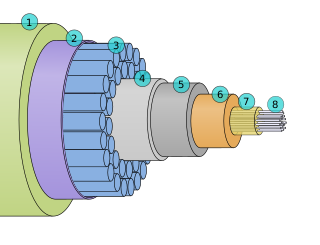
ATLANTIS-2 is a fiber optic transatlantic telecommunications cable connecting Argentina, Brazil, Senegal, Cape Verde, Spain's Canary Islands and Portugal. It is the first submarine cable to link Latin America and the African continent.

Arica is a commune and a port city with a population of 222,619 in the Arica Province of northern Chile's Arica y Parinacota Region. It is Chile's northernmost city, being located only 18 km (11 mi) south of the border with Peru. The city is the capital of both the Arica Province and the Arica and Parinacota Region. Arica has a mild, temperate climate with some of the lowest annual rainfall rates anywhere in the world; consequently, there are rarely any clouds over Arica. Arica is located at the bend of South America's western coast known as the Arica Bend or Arica Elbow. At the location of the city are two lush valleys that dissect the Atacama Desert converge: Azapa and Lluta. These valleys provide fruit for export.
The Americas Region Caribbean Ring System (ARCOS-1) is a fiber optic submarine communications cable of 8,400 kilometers that extends between the United States, the Bahamas, the Turks and Caicos Islands, the Dominican Republic, Puerto Rico, Curaçao, Venezuela, Colombia, Panama, Costa Rica, Nicaragua, Honduras, Guatemala, Belize, and Mexico. Because of its length, it was divided in two phases: Phase 1 being in service since September 2001 and Phase II since March 2002. The cable system was set in a ring configuration and is operated on a non-common carrier basis.

The Australia–Japan Cable, or AJC, is a 12,700 km submarine telecommunications cable system linking Australia and Japan via Guam that became operational in 2001. It had an original design capacity of 640 Gbit/s, but was initially equipped to use only 80 Gbit/s of this capacity. In April 2008 a capacity upgrade was completed, bringing equipped capacity to 240 Gbit/s. Design capacity was also increased to 1000 Gbit/s. Further upgrades will increase equipped capacity to meet increasing demand.

EAC-C2C is a submarine telecommunications cable system interconnecting several countries in Asia, the Pacific, and the United States. It is a merger of the former EAC and C2C cable systems. The merger occurred in 2007 by Asia Netcom, and the cable system is now owned/operated by Pacnet. Pacnet was acquired by the Australian telecommunications company Telstra in 2015.
Apollo is an optical submarine communications cable system crossing the Atlantic Ocean, owned by Apollo Submarine Cable System Ltd. It consists of 2 segments North and South, creating two fully diverse transatlantic paths.
G-P is a submarine telecommunications cable system in the North Pacific Ocean linking the two named territories.
Arica is a city in northern Chile.

MAYA-1 is an optical submarine telephone cable.
SAm-1 is an optical submarine communications cable. It started operations in 2000, connecting the United States, Puerto Rico, Brazil, Argentina, Chile, Peru and Guatemala. In 2007, SAm-1 was extended to reach Ecuador and Colombia.
Telecommunications in Panama includes radio, television, fixed and mobile telephones, and the Internet.
GlobeNet is a wholesale telecom operator that connects the Americas with various services, supported by its 23,500-kilometer (14,600 mi) subsea cable system and IT infrastructure.

TPE or Trans-Pacific Express is a submarine telecommunications cable linking China, South Korea, Taiwan, Japan, and the United States. The line is a $500 million USD joint venture between 6 telecommunication companies China Telecom, China Netcom, China Unicom, Chunghwa Telecom, Korea Telecom, and Verizon Communications. Ownership of the cable is evenly split between the 6 participants. Construction of this 11,000 miles line was completed in September 2008, and the Japan branch was completed in January 2010.

Chacalluta International Airport is an airport serving the city of Arica, capital of the Arica Province in the northern Arica y Parinacota Region of Chile. It is 18.5 kilometres (11.5 mi) northwest of the city and 1 kilometre (0.62 mi) south of the border with Peru.
The Main One Cable is a submarine communications cable stretching from Portugal to South Africa with landings along the route in various west African countries. On April 28, 2008, it was announced that Main Street Technologies has awarded a turnkey supply contract for the Main One Cable System to Tyco Telecommunications.

The West Africa Cable System (WACS) is a submarine communications cable linking South Africa with the United Kingdom along the west coast of Africa that was constructed by Alcatel-Lucent. The cable consists of four fibre pairs and is 14,530 km in length, linking from Yzerfontein in the Western Cape of South Africa to London in the United Kingdom. It has 14 landing points, 12 along the western coast of Africa and 2 in Europe completed on land by a cable termination station in London. The total cost for the cable system is $650 million. WACS was originally known as the Africa West Coast Cable (AWCC) and was planned to branch to South America but this was dropped and the system eventually became the West African Cable System.
Honotua is a submarine communications cable system that connects several islands of French Polynesia via Tahiti to Hawaii. The cable was laid by the cableship Île de Ré between December 2009 and June 2010.
Cable & Wireless Communications Ltd operating as C&W Communications is a telecommunications company which has operations in the Caribbean and Central America. It is owned by Liberty Latin American and is headquartered in London, United Kingdom.








